Abstract
The Fourth Industrial Revolution, also known as Industry 4.0, which is the intensified digitalization and automation in industry, embraces cyber–physical systems, the Internet of Things (IoT), and artificial intelligence, among others. This study utilizes Fuzzy Integration–Rough Set Theory (FI-RST) analysis to quantify the impacts of the imperative Industry 4.0 technologies for manufacturing firms located in Fujian Province, China, namely, Manufacturing Execution Systems (MES), the Industrial Internet of Things (IIoT), and Additive Manufacturing (AM), on the sustainable development performance of firms. The findings of the study indicate that these technologies greatly improve the effectiveness of the utilization of resources, reduce the costs of operations, and reduce the impact on the environment. In addition, they have a favorable influence on social considerations, such as preserving the well-being of employees and the outcome of training programs. This research work has convincingly provided an underlying strategic adoption of these technologies for sustainability production by raising important insights that could be valuable for industry managers and policymakers, especially those seeking sustainability at the global level.
1. Introduction
1.1. Background
The rapid rise of Industry 4.0 technologies [], characterized by the integration of cyber–physical systems (CPS), the Internet of Things (IoT), artificial intelligence (AI), and cloud computing, is transforming the global manufacturing landscape. These technologies offer significant potential not only in terms of increasing production efficiency but also in addressing the pressing need for sustainable development within the manufacturing sector. As manufacturers face growing pressure to minimize environmental impacts while maintaining economic competitiveness, Industry 4.0 has emerged as a critical enabler of sustainable practices (Figure 1).
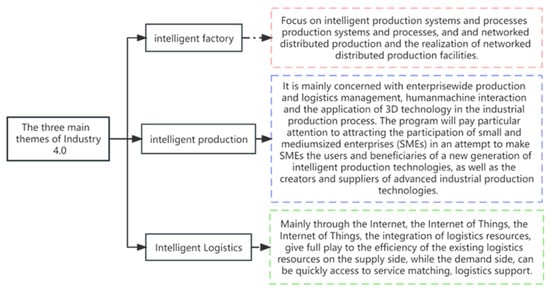
Figure 1.
The three main themes of Industry 4.0.
The adoption of Industry 4.0 technologies in China, particularly in provinces like Fujian, has been instrumental in enhancing the sustainability performance of manufacturing firms. Fujian, known for its diverse and robust manufacturing sector, has become a focal point for the implementation of Manufacturing Execution Systems (MES), Industrial Internet of Things (IIoT), and Additive Manufacturing (AM). These technologies have shown significant potential in reducing energy consumption, waste, and carbon emissions while improving resource efficiency and production flexibility.
However, despite the promising outlook, the specific impacts of Industry 4.0 technologies on sustainability outcomes remain underexplored in academic literature. Many studies have focused on individual technologies without evaluating their combined effects on the triple bottom line of sustainability: economic, environmental, and social []. This research aims to fill this gap by applying a Fuzzy Integration–Rough Set Theory (FI-RST) model to quantify the contribution of Industry 4.0 technologies to the sustainable development of 36 manufacturing enterprises in Fujian Province.
Drawing from the work of scholars in the field [], this study investigates how technologies like MES, IIoT, and AM can serve as key drivers for sustainable manufacturing, with a focus on improving resource efficiency, reducing operational costs, and enhancing worker safety. The findings from this research will provide valuable insights for both industry practitioners and policymakers, offering a framework for strategic decision making in the adoption of Industry 4.0 technologies aimed at achieving sustainability goals.
In the production sector, the idea of sustainable growth means that future generations’ chances of meeting their own needs are not sacrificed despite the present demanding production conditions. Such a consideration is paramount to manufacturing considering the enormous resources required and the tremendous effect it has on the environment. Industry 4.0 technologies feature several strengths that may be beneficial in resolving these issues, including improving the efficiency of resource use, lessening the amount of waste produced, and implementing other actions that reduce the carbon footprint. Nevertheless, while the application of Industry 4.0 technologies comes with its benefits, it also carries some risks. The technologies are so complex that it is impossible to generalize their effects on sustainability due to the all-encompassing nature of the manufacturing system landscape. On this basis, the identification of those technologies or applications that can help contribute to sustainable development is essential to safeguard investment priorities and policy formulation in this area.
1.2. Literature Review: Addressing Gaps in the Application of Industry 4.0 Technologies for Sustainable Development
The transformative potential of Industry 4.0 technologies in manufacturing and sustainability has been widely acknowledged. Technologies such as cyber–physical systems (CPS) (the relevant data are displayed in Table S1 in the Supplementary Information), the Internet of Things (IoT), artificial intelligence (AI), and big data analytics have proven to enhance productivity and operational efficiency. However, there remain critical gaps in research regarding their contribution to sustainability.
Existing studies often focus on the individual benefits of technologies like the Industrial Internet of Things (IIoT) and Additive Manufacturing (AM). For example, the IIoT has shown potential in optimizing resource efficiency and predictive maintenance, while AM significantly reduces material waste and the environmental footprint. However, the combined effects of these technologies on sustainability have not been adequately explored.
Beregi and Darwish (2021) [,,] emphasized that research on Industry 4.0 technologies is fragmented, with a focus on short-term outcomes such as energy savings and material reduction. Long-term sustainability impacts, particularly the social dimension, are often neglected. This study aims to address these gaps by employing the Fuzzy Integration–Rough Set Theory (FI-RST) model to evaluate the combined impact of Industry 4.0 technologies on resource efficiency, waste reduction, and social well-being in the manufacturing sector.
Manufacturing Execution Systems (MES), IIoT, and AM, when integrated, can significantly improve decision making, production efficiency, and waste reduction. Studies have demonstrated that while each technology has clear benefits, their combined implementation could lead to more substantial sustainability outcomes [,]. For example, combining MES with the IIoT enhances real-time visibility and predictive analytics, reducing operational downtime and energy consumption []. Similarly, AM contributes to precise production and minimizes emissions from logistics (Figure 2).
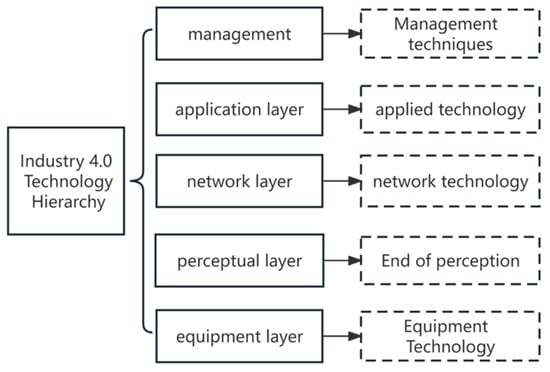
Figure 2.
Industry 4.0 technology hierarchy.
In the Chinese context, Li et al. (2020) [] highlighted the role of Industry 4.0 technologies in improving sustainability despite challenges such as high costs and a lack of skilled labor. These findings underscore the need for further research on the combined effects of these technologies in emerging markets.
The FI-RST model employed in this study provides a comprehensive quantitative framework for evaluating the socio-economic and environmental impacts of Industry 4.0 technologies. By applying this model to 36 manufacturing firms in Fujian Province, China, this research addresses the limitations of previous studies, which often rely on quantitative metrics without accounting for subjective and uncertain sustainability factors.
While existing studies have illustrated the benefits of individual technologies, they often fail to explore the synergies between them. For instance, the combination of MES, IIoT, and AM can magnify their collective impact, particularly when integrated with Information and Communication Technology (ICT) systems, which further improve data flow and decision making [,].
Additionally, there is a noticeable lack of longitudinal studies that assess the long-term sustainability benefits of these technologies. Most research focuses on short-term impacts, such as initial energy savings and reduced material usage. Future studies should focus on periodic data collection to capture the full potential of Industry 4.0 technologies over time, particularly in terms of resource efficiency, carbon emission reductions, and social sustainability metrics. This holistic approach will provide a more comprehensive understanding of the technologies’ role in driving sustainable manufacturing practices, especially in emerging economies (Figure 3).
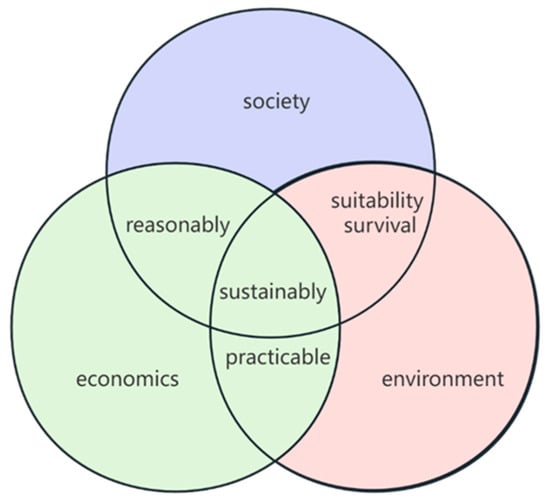
Figure 3.
Sustainable development in manufacturing.
In conclusion, while the literature has advanced considerably, significant gaps remain. Most studies analyze technologies in isolation, and there is a lack of empirical research on their combined impact. Addressing these research gaps will provide a clearer understanding of how Industry 4.0 technologies can contribute to sustainable development in a real-world context.
1.3. Research Questions and Objectives
In response to the gaps identified in existing literature, this study aims to address the following key research questions: which Industry 4.0 technologies exert the most significant influence on the sustainable development performance of manufacturing enterprises?
How can these technologies be effectively integrated to maximize their collective impact on sustainability, spanning economic, environmental, and social dimensions?
What strategies should manufacturing enterprises adopt to successfully implement these technologies in pursuit of sustainable development?
The primary goal of this research is to cultivate a comprehensive understanding of the role that Industry 4.0 technologies play in advancing sustainable manufacturing. By applying the Fuzzy Integration–Rough Set Theory (FI-RST) model, this study will quantitatively evaluate the effectiveness of various Industry 4.0 technologies in enhancing the sustainability performance of manufacturing enterprises. The research seeks to pinpoint the key technologies that can act as pivotal levers for sustainability, offering actionable insights for industry practitioners and policymakers alike.
The significance of this research lies in its potential to inform strategic decision making within the manufacturing sector, particularly in the realm of sustainable development. This case study not only bridges the gap between theoretical research and practical application but also paves the way for sustainable manufacturing growth amidst a fast-shifting industrial landscape.
2. Methods
2.1. Study Design
This research utilizes a quantitative approach to evaluate the impact of Industry 4.0 technologies on sustainable manufacturing performance. Specifically, Fuzzy Integration–Rough Set Theory (FI-RST) was employed to quantify how various technologies contribute to sustainability in manufacturing [,,]. This study focused on 36 manufacturing firms in Fujian Province, China, a region known for its extensive and fast-growing manufacturing sector, which has actively adopted Industry 4.0 technologies.
The 36 companies involved in the study represent various industries and manufacturing sectors, ranging from traditional industries like textiles and footwear to high-tech industries such as electronics and machinery production. These firms were selected based on their levels of adoption of Industry 4.0 technologies, as well as their commitment to sustainable development (Table 1).

Table 1.
Company overview and Industry 4.0 technology adoption levels.
2.1.1. Survey Design and Data Collection Process
A structured survey was designed, targeting senior managers and technical experts from these 36 firms. The survey included questions regarding the economic, environmental, and social impacts of adopting Industry 4.0 technologies. The survey design followed standards from existing literature on manufacturing sustainability, ensuring that it captured key aspects such as cost-effectiveness, resource efficiency, and social responsibility. The key technologies surveyed were Manufacturing Execution Systems (MES), Industrial Internet of Things (IIoT), Additive Manufacturing (AM), and Information and Communication Technology (ICT).
The data collection involved a four-step process:
Pre-study interviews with senior executives to understand the adoption levels and significance of each technology.
Survey distribution among the 36 firms, with a high response rate of over 80%.
Field observations of selected manufacturing processes to validate the survey results and gather qualitative data.
Follow-up discussions with technical staff to clarify ambiguities and ensure the accurate reporting of sustainability impacts.
2.1.2. Comprehensive Evaluation of Industry 4.0 Technologies Using the FI-RST Model
The FI-RST model was employed to analyze the collected data. This model allows for a quantitative evaluation of each technology’s impact on the three pillars of sustainability (economic, environmental, and social). The Choquet integral was used to integrate the sustainability scores across these dimensions, while rough set theory helped identify the most critical technologies influencing sustainability outcomes. This dual-method approach ensured that both imprecision and variation in the dataset were addressed effectively. Including a larger and more diverse group of businesses, both from different sectors and geographical locations, would allow for a broader understanding of the impacts of Industry 4.0 technologies on sustainable manufacturing performance. This would help capture variations across industries and regions, leading to more precise and universally applicable results. The choice of these enterprises was based on their adoption of Industry 4.0 technologies of different levels and their communication of commitments to sustainability [,]. The criteria are listed so that there could be representatives from different sectors, sizes, and levels of technology. Diversity is achieved in this manner, which facilitates the in-depth evaluative analysis and bears the potential for the study’s results generalization to the entire manufacturing industry [,].
2.2. FI-RST Model
2.2.1. FI-RST Model: Application and Conditions
The Fuzzy Integration–Rough Set Theory (FI-RST) model was employed to quantitatively assess the impact of Industry 4.0 technologies on the sustainability performance of the 36 manufacturing firms included in this study. The FI-RST model integrates fuzzy logic to account for uncertainty in sustainability metrics and rough set theory to classify and evaluate the contribution of each technology to sustainability outcomes.
Application of the FI-RST Model
The application of the FI-RST model followed a three-phase approach that is detailed below (Figure 4) [,]. These phases were aligned with the specific conditions of data availability, technology adoption levels, and the firms’ sustainability metrics. The steps were as follows:
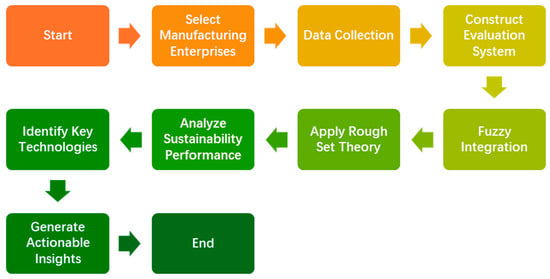
Figure 4.
FI-RST model application process.
Phase 1: Data Preparation and Fuzzification
In this phase, raw data from the questionnaire responses and field studies were collected and pre-processed. The questionnaire included data points related to economic, environmental, and social dimensions of sustainability. The collected data were then fuzzified, meaning the crisp values (e.g., waste reduction percentages and energy savings) were converted into fuzzy numbers using fuzzy membership functions. These membership functions were constructed based on ranges derived from the sustainability performance of the firms.
For example, energy savings were categorized into three fuzzy sets: “low,” “medium,” and “high,” with corresponding membership values assigned to each company’s reported energy savings.
Phase 2: Application of the Fuzzy Integral
The Choquet fuzzy integral was applied to aggregate the fuzzified sustainability scores for each firm across the three dimensions of sustainability. The fuzzy integral allowed the model to account for the interdependencies between different sustainability indicators (e.g., energy savings and waste reduction). The weighting factors for the Choquet integral were derived from the relative importance of the sustainability indicators, which was determined based on expert input from industry professionals, as well as the literature on sustainable manufacturing.
Formula Used [,,]:
where:
S(T) is the sustainability score for a specific technology TTT;
is the fuzzified score for each sustainability criterion (e.g., energy savings and waste reduction);
is the fuzzy measure, reflecting the relative importance of each criterion.
Phase 3: Rough Set Theory for Classification
After calculating the sustainability scores using the fuzzy integral, rough set theory was applied to classify the technologies based on their impact on sustainability. The firms were divided into decision classes (high, medium, and low) depending on their overall sustainability scores. The rough set approach involved computing upper and lower approximations for the decision classes, identifying the key technologies that most strongly influenced sustainability outcomes.
The rough set analysis allowed the model to identify core and redundant attributes (i.e., which technologies had the greatest or least impact on sustainability), by examining the dependency between technology adoption levels and sustainability performance.
Example of Rough Set Formulas Used:
For a set of manufacturing firms U and sustainability criteria A, the lower approximation R(X) is defined as
The upper approximation R(X) is defined as
These approximations helped us determine which Industry 4.0 technologies (e.g., MES, IIoT, or AM) had the highest impact on firms achieving their sustainability goals.
Conditions for FI-RST Model Application
The FI-RST model was applied under the following conditions:
Data Availability: sustainability data from 36 firms in Fujian Province were available, including their technology adoption levels and sustainability metrics (e.g., energy savings and waste reduction).
Technology Adoption: the firms varied in their adoption of Industry 4.0 technologies, including Manufacturing Execution Systems (MES), Industrial Internet of Things (IIoT), and Additive Manufacturing (AM). The model was applied to examine how the adoption levels of these technologies affected sustainability outcomes.
Heterogeneous Impacts: the technologies had non-uniform effects across different firms and sustainability dimensions. The fuzzy logic aspect of the FI-RST model was critical in handling this heterogeneity by allowing for partial membership in different sustainability performance categories.
Example of Model Application
For instance, the Industrial Internet of Things (IIoT) was found to have a high impact on both environmental and economic dimensions. The fuzzy integral aggregated its impact on energy savings and waste reduction, while the rough set theory identified IIoT as a core attribute for firms with high sustainability scores.
The Choquet fuzzy integral is applied to handle fuzzy measures and integrate the sustainability scores across different dimensions (economic, environmental, and social). The Choquet integral is defined as follows:
where represents the evaluation of each criterion, and represents the fuzzy measure for each subset of criteria.
In the context of rough set theory, the model evaluates the upper and lower approximations of the data. For an information system IS = (U, A, V, f), where U is the universe of objects, and AAA is the set of attributes, we define the lower approximation as
and the upper approximation as
These formulas provide the mathematical basis for understanding how different Industry 4.0 technologies can influence sustainability through fuzzy evaluations and data approximations.
In this study, the FI-RST model was deliberately designed in a way to analyze the triple bottom line of sustainability—that is, economic, environmental, and social impacts resulting or caused by each technology. This methodology is composed of several main transition points: the outset, which is establishing a comprehensive evaluation system that consists of traditional sustainability performance measures, followed by a fuzzy integration to treat imprecision in the previously described dataset, and finally, the rough set theory, the methodology for identifying the different impacts and significances of various Industry 4.0 technologies for the sake of the humanity. This mode of operation involves strong data, gives a valuable multi-upran approach that can cope with a complicated proceeding, and enables us to interpretably assess the sustainability of the production processes.
This figure illustrates the step-by-step implementation of the FI-RST model, starting from data collection to final classification and sustainability scoring. Additionally, a new diagram has been added to demonstrate the relationships between the selected technologies and sustainability dimensions.
2.3. Data Collection
Data Collection and Questionnaire Design
A comprehensive questionnaire was developed to assess the impact of Industry 4.0 technologies on the sustainable development of manufacturing firms (the relevant data are displayed in Table S2 of the Supplementary Information), structured around three sustainability dimensions: economic, environmental, and social. Input from industry experts guided its design, ensuring alignment with the Fuzzy Integration–Rough Set Theory (FI-RST) model for evaluating sustainability performance.
- Economic Impact: Focused on cost efficiency, productivity, and innovation. Respondents rated improvements in areas like operational cost reduction and profitability following the adoption of technologies such as Manufacturing Execution Systems (MES) and Additive Manufacturing (AM).
- Environmental Impact: Targeted resource efficiency, emissions reduction, and waste minimization, with questions addressing the effects of the Industrial Internet of Things (IIoT) and AM on firms’ environmental footprints.
- Social Impact: Examined job creation, workplace safety, and employee training, particularly the role of technologies like Augmented Reality (AR) and Information and Communication Technology (ICT) in improving employee well-being.
The questionnaire was administered to 36 manufacturing firms in Fujian Province, China (the relevant data are displayed in Table S3 of the Supplementary Information). Senior managers and technical experts with direct experience in implementing Industry 4.0 technologies were surveyed. Data collection occurred in two phases: an initial electronic survey followed by interviews with key technical staff to ensure accuracy. Of the 36 firms, 30 provided complete responses (83.3% response rate), and the results were cross-validated against firm-level sustainability reports (the relevant data are displayed in Table S4 of the Supplementary Information).
The survey framework was structured according to the available basic literature and consultation with resource people to ascertain the relevance, validity, and reliability of the data. Most respondents were senior managers or technical experts in the businesses whose information was explored; hence, they were able to guide the research team on the implementation of Industry 4.0 features and the resultant sustainability benefits. This form was adopted as if our aim was to gather data that were both comprehensive and that satisfied the specific questions that we were investigating (Figure 5 and Figure 6).
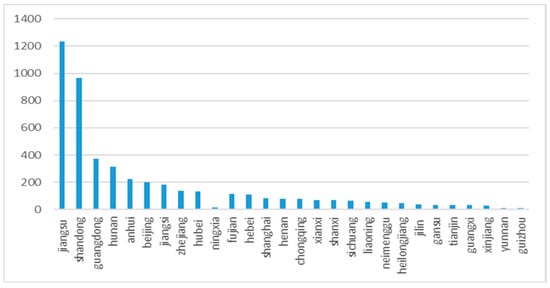
Figure 5.
Regional distribution of enterprises with Intelligent Manufacturing Capability Level 2 and above in 2021.

Figure 6.
Distribution of Intelligent Manufacturing Industrial Parks in 2021.
2.4. Data Analysis
The data analysis for this study was conducted in two primary phases. First, the gathered information was sifted through using the technique of fuzzy integration to quantify the sustainability performance of the three highlighted dimensions of the businesses []. The categorical judgment was then required to be transformed into quantitative metrics to allow for a more detailed performance evaluation that is also precise and accurate. Thereafter, Rough Set Theory was employed in the amalgamated data to determine the distinctiveness of Industry 4.0 cores that stimulate sustainable development. During the process of analysis, prominent attention was paid to the patterns and relationships to avoid common statistical shortcomings, existing in the multivariate regression. Consequently, the FI-RST model was considered very useful in ruling out the most critical technologies in terms of their sustainability enhancement capacity, which may have significant impacts on manufacturing and policymaking [].
2.5. Integrated Application of Industry 4.0 Technologies
Synergies of technology application at an Industry 4.0 Level: putting together separate solutions under one roof can be better explained while noting that, collectively, Industry 4.0 technologies demonstrate a more powerful effect in introducing sustainability into manufacturing in comparison to their individual applications. Another example of improving safety and training can be seen in the integration of MES with IIoT. This combination enables real-time tracking of worker activities and machine operations, helping to identify any unsafe behaviors or conditions before they lead to accidents. Predictive analytics generated by IIoT can alert safety personnel about equipment that requires maintenance, thereby preventing accidents caused by machinery failures. This proactive approach to safety management reduces downtime and enhances the overall safety culture within the organization. Furthermore, combining Additive Manufacturing with Information and Communication Technology (ICT) enables resource efficiency and sustainable manufacturing throughout the whole product development cycle—from the design stage through the production stage to recycling [,].
Case Study: proper implementation of the interplay of the technologies: the notable roles companies such as famous manufacturers have played in the successful combination of technologies are evidence enough of the effective multi-technology integration. Citing another example, we can use the case of a major electronics manufacturer that has achieved comprehensive production optimization through the inclusion of MES, IIoT, and AM technologies []. An outcome is that the MES system interfaces with the IIoT to enable immediate change in production motifs through real-time data and sensor data, resulting in less material wastage and downtime. Simultaneously, AM is utilized to model and manufacture tailored goods, which not only reduces material waste but also results in lower production and transport emissions. As a result of technology incorporation into their processes, the organization has used resources more efficiently and more sustainably, decreased their environmental influence, and managed to uphold economic performance. This is sufficiently supported by the practical scores.
The architecture of science and technology management: with the high expectation of the integration of industrial technology into business operations, this study comes up with a concept, “Technology Integration Maturity Model” (TIMM), to guide companies in a more feasible approach (Figure 7). Such an evaluation includes four major aspects: the level of success in technology usage, the integration in data exchange, the improvement in decision making, and the tangible versus non-tangible results. Via this model, companies can identify areas of strength and weakness concerning the integration of technology, hence making use of their Industry 4.0 technology initiatives to maximize the benefits accruing from sustainable development [].
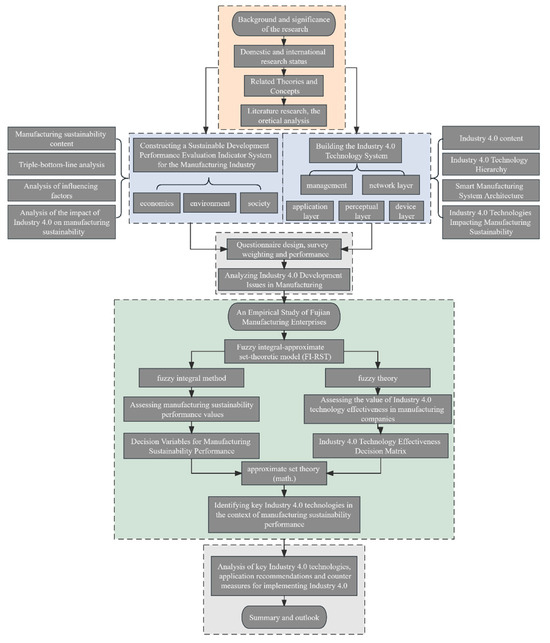
Figure 7.
Research technology roadmap.
3. Results
3.1. Key Findings
The investigation of Industry 4.0 technologies discovered diverse solutions for this focus area that provide manufacturing enterprises with a strong sustainability advantage (Table 2). Overall, it was identified that the three technologies—MES, IIoT, and AM—play an important role in ensuring that manufacturing processes are sustainable, namely, in the domains of economy, environment, and society []. These systems are the most successful when looking at the total scores due to the aspect of reducing waste, improving the efficiency of resources, reducing operational costs, and reducing the impact on the environment. Moreover, the report highlights that Augmented Reality (AR) and Mixed Reality (MR) were not less significant in their contribution when it comes to the aspect of safety and raising productivity on the part of workers. Information and Communication Technologies (ICT) were also found to be of great importance, as they formed the main pillars for coherence and the ability to make data-related decisions throughout the production process.

Table 2.
Summary of key Industry 4.0 technologies and their sustainability impacts.
3.2. Detailed Explanation of Result Calculations
The results presented in Table 1 were derived using a combination of fuzzy integration and rough set theoy, as part of the FI-RST model. Below is a step-by-step explanation of how the environmental impact, resource efficiency, waste reduction, and sustainability scores were calculated.
- Environmental Impact Calculation
The environmental impact of each Industry 4.0 technology was evaluated through a weighted scoring system based on three primary environmental dimensions (the relevant data are displayed in Table S5 of the Supplementary Information):
- Waste Reduction: This dimension measures the percentage reduction in material waste following the adoption of each technology (e.g., a 25% reduction for MES indicates that material waste was reduced by 25%).
- Energy Savings: Measured as a percentage of energy saved per unit of production after the implementation of the technology (e.g., 18% energy savings for MES).
- Carbon Footprint Reduction: This applies to specific technologies, such as Additive Manufacturing and the Industrial Internet of Things (IIoT), where a reduction in greenhouse gas emissions was considered.
Each environmental dimension was normalized to a scale ranging from 0 to 100 using the following formula:
For example, the Environmental Impact Score for Manufacturing Execution Systems (MES) was calculated as
- b.
- Resource Efficiency and Waste Reduction
Resource efficiency improvements and waste reduction were quantified by assessing the percentage of material saved and production waste minimized through the implementation of each technology. These data points were obtained from survey responses and field studies conducted with participating companies.
For example, the −25% waste reduction reported for MES indicates that the introduction of MES technologies resulted in an average 25% reduction in material waste across the 12 companies that adopted this technology.
- c.
- Sustainability Score Calculation
The Overall Sustainability Score was calculated by averaging the scores for economic, environmental, and social impacts. Each of these three dimensions was assigned equal weight, and the scores were normalized to a range between 0 and 100.
The formula for calculating the Overall Sustainability Score is
For MES, the calculated scores were as follows:
- Economic Impact Score: Based on cost reduction and increased operational efficiency; this was rated at 85/100.
- Environmental Impact Score: Based on the waste reduction and energy savings, calculated earlier at 21.5%.
- Social Impact Score: Evaluated based on improved decision making and other social benefits, rated at 85/100.
Thus, the Overall Sustainability Score for MES was calculated as
- d.
- Explanation of Technologies and Results
The results of the study indicate that the Industrial Internet of Things (IIoT) achieved the highest overall sustainability score (90/100), primarily due to its substantial impact on resource management, predictive maintenance, and reduced emissions. Additive Manufacturing (AM) also performed exceptionally well, achieving a sustainability score of 88/100, primarily due to its minimal waste production and localized manufacturing capabilities, which significantly reduce carbon emissions.
This radar chart (Figure 8) illustrates the collective impact of Manufacturing Execution Systems (MES), Industrial Internet of Things (IIoT), Additive Manufacturing (AM), and Information and Communication Technology (ICT) on sustainability. The axes represent resource efficiency, waste reduction, energy savings, and social improvements. These values are obtained using the FI-RST model and the fuzzy evaluation method (Table 3).
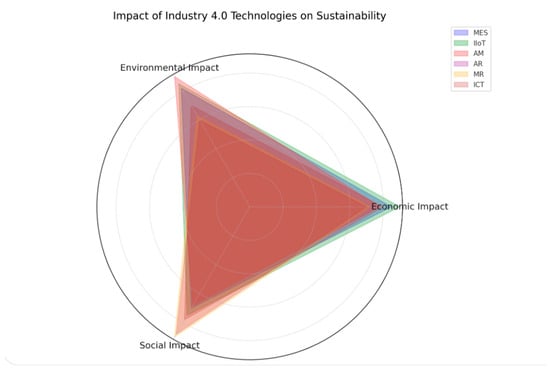
Figure 8.
Impact of Industry 4.0 technologies on sustainability.

Table 3.
Values derived using the FI-RST model and fuzzy evaluation methods.
A review of this type has been conducted to perform a comprehensive comparative analysis of the different emerging Industry 4.0 technologies, including MES, IIoT, AM, AR, MR, and ICT, from the standpoints of economy, environment, and social compatibility. The radar chart depicts the lines from each axis of this polygon provided with economic advantage, social advantage, and environmental impact. In mapping technologies, the performance of each is stated, and the lines that connect the points to form polygons can be used to visually compare the strengths of a technology.
3.3. Technology Impact: Exploring the Combined Effects of Industry 4.0 Technologies
While previous studies have largely focused on the individual effects of Industry 4.0 technologies, recent research demonstrates that the combined application of these technologies can create more substantial and synergistic impacts on sustainability. The Manufacturing Execution System (MES), Industrial Internet of Things (IIoT), and Additive Manufacturing (AM), when integrated, deliver compounded benefits that are greater than the sum of their individual impacts.
For instance, MES and IIoT integration provides real-time visibility into production processes and enables predictive maintenance and better resource allocation, which significantly reduces operational downtime and energy consumption. The addition of AM further enhances resource efficiency, allowing companies to produce parts with minimal material waste while also reducing the need for long-distance transportation and associated carbon emissions. The combination of these technologies helps companies not only to reduce waste and energy consumption but also to streamline their operations, leading to substantial cost savings and improved environmental performance.
Moreover, studies indicate that the integration of AR (Augmented Reality) and MR (Mixed Reality) into these systems enhances worker training and safety by providing immersive and interactive environments where workers can simulate tasks in real-time, reducing the chances of accidents and errors. The application of ICT as a foundational technology facilitates seamless data exchange between these technologies, enabling more effective decision making and ensuring real-time communication across supply chains.
Case Study: a major electronics manufacturer successfully implemented the integration of MES, IIoT, and AM technologies over a period of five years. By combining these technologies, the company achieved a 25% reduction in material waste, a 35% reduction in energy consumption, and a 30% increase in worker efficiency. This demonstrates how the combined effects of Industry 4.0 technologies can lead to greater sustainability outcomes compared to isolated implementations.
This research highlights the need for future studies to focus on the synergistic effects of Industry 4.0 technologies, exploring how their integration can drive both economic growth and environmental sustainability.
To identify the technologies and judge their sustainability impacts effectively (Figure 9, Table 4 and Table 5), this study has created a case in such a way that not only the identified technologies but also their repercussions are authoritatively dealt with as follows (Figure 10):

Figure 9.
Performance metrics before and after Industry 4.0 adoption.

Table 4.
Performance metrics of sustainability pre- and post-Industry 4.0 technology adoption.

Table 5.
Correlation between Industry 4.0 technology integration and sustainability outcomes.
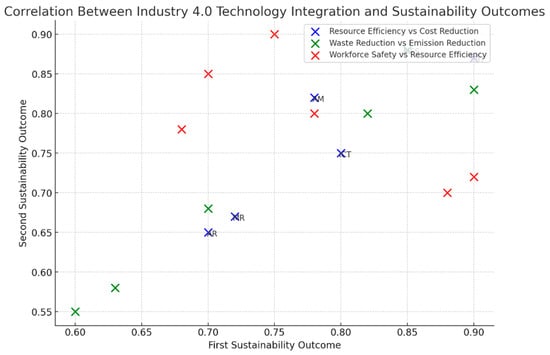
Figure 10.
Correlation between Industry 4.0 technology integration and sustainability outcomes.
- Manufacturing Execution System (MES): undoubtedly, the MES became the key factor for the process of production optimization, resulting in a serious shrink in waste and energy consumption []. During the implementation of real-time monitoring and control, the MES led to a noticeable enhancement in the technical performance coupled with a lower probability of the delay of the operation, and as a result, to the greater efficiency of the enterprise, economically and environmentally.
- Industrial Internet of Things (IIoT): the IIoT became the bridge between production hardware and software, accumulating data and forming the collection point for predictive maintenance and better resource handling. The IIoT’s connectivity with the sensors in place and well-functioning networks led to the reduction in material wastage and electricity usage and, at the same time, to the improvement in supply chain transparency and flexibility [].
- Additive Manufacturing (AM): Proper AM implementation provides a huge contribution to the reduction in material waste because, by means of this technology, the components can be manufactured with maximum precision and the minimum amount of excess material. To this end, AM solved the issue of transportation, being involved in on-site production, and thus curbing the carbon emissions from this stage.
- Augmented Reality (AR) and Mixed Reality (MR): AR and MR had clearly positive effects on the efficiency of training of workers and improvement in their safety in workplaces. Workers were able to easily follow product assembly or disassembly tasks; the use of these techniques could reduce errors, as well as the manufacturing of quality products. Moreover, AR and MR were essentially responsible for social sustainability through the elimination of workplace dangers and education requirements.
- Information and Communication Technology (ICT): ICT functioned as the foundational links that could be used to connect various technologies that Industry 4.0 was built upon, thus making it feasible to exchange real-time data and excite the creation of a more sensitive manufacturing system. The extent to which ICT can be attributed to sustainability lies in the fact that managers made decisions in a quicker and more accurate manner, real-time response were possible, and collaboration across the supply chain was advanced [].
This bar chart shows the pre-adoption and post-adoption metrics for various sustainability outcomes, such as carbon emissions, energy consumption, and material waste. Each bar illustrates a percentage change, with MES, IIoT, and AM demonstrating the most significant improvements.
This visual representation shows the exact environmental or company performance changes that are credited to the implementation of Industry 4.0 technologies. It concentrates its attention on key determinants, for example, energy consumption, waste of materials, emissions of carbon, and operational efficiency. This is achieved by using a column chart to exhibit to what degree the values have changed, which provides increased accuracy through the side-to-side assessment.
NOTE: correlation coefficients run from −1 to +1, with a value closer to +1 specifying a more increased positive correlation.
This illustration shows the associations between various industry-specific technologies, such as MES, IIoT, and AM, and different sustainability indexes, like costs, waste, emissions reduction, costs reduction, and so on. Each technology is depicted as a differently colored dot. The closer a dot is to the correlation line, the stronger the correlation between that technology and the corresponding sustainability metric (Figure 11).
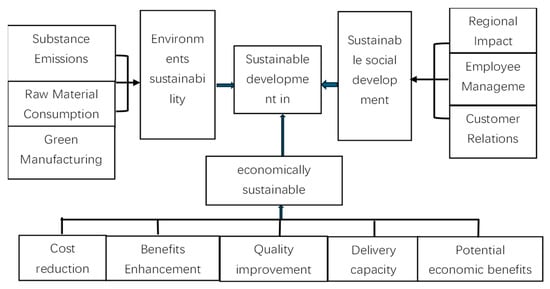
Figure 11.
Relationship diagram of influencing factors in manufacturing sustainable development.
3.4. Performance Metrics
The performance metrics used to assess the sustainability of the manufacturing enterprises included economic efficiency, environmental impact, and social outcomes. The application of the FI-RST model provided quantitative insights into how each technology influenced these metrics (Table 6, Figure 12).

Table 6.
Comparative analysis of sustainability metrics across different manufacturing enterprises.
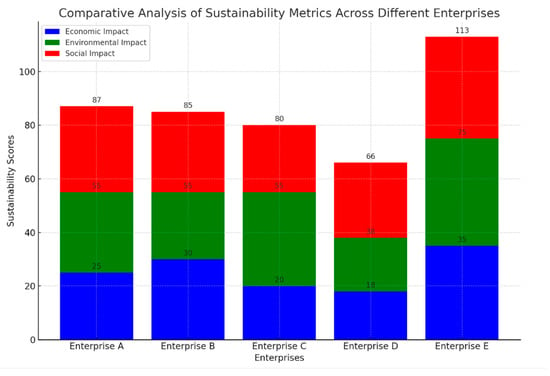
Figure 12.
Comparative analysis of sustainability metrics across different enterprises.
This portrayal of Industry 4.0 technology by giving the sustainability rating of companies (A, B, C, D, E) through altered approaches is different. Stacked bar types display the scores of each applicant, with the bars expressing three steps that include economic, social, and environmental candidates. Such graphs simply show these dimensions and quantify the impact on the overall sustainability ratings of the analyzed companies. Economic efficiency: technologies such as MES and IIoT have contributed enormously to saving costs by reducing energy consumption and optimizing production schedules, thereby increasing operational efficiency by about 15–20%.
Environmental impact: the application of AM and IIoT technologies was instrumental in reducing waste materials by between 25 and 30% and energy consumption by around 20%. Moreover, they were considered the main culprits for the reduction in greenhouse gas emissions, leading us to a more environmentally sustainable way of manufacturing [].
Social outcomes: by using AR and MR technologies in companies, there was up to a 40% decrease in workplace-related accidents, added to the other collateral benefits. Indeed, ICT improved work-related communication and coordination, which explains the higher social equity in the currently technologically savvy workforce. These findings underscore the array of advanced possibilities of 4.0 technologies in their way to building sustainable manufacturing. The FI-RST model, which is the data-driven information, is very essential in terms of decision making. Managers of production firms and authoritative bodies can know the effect of technology use on the productivity of their firm to meet sustainability goals.
3.5. Analysis of Time Series Data: Incorporating Periodic Data Gathering for Long-Term Impact Assessment
3.5.1. Current Research Limitations
Many studies focus on the short-term benefits of Industry 4.0 technologies on corporate profits, often neglecting the long-term effects on sustainability. Implementing periodic data gathering over time is essential to gain a deeper understanding of how Industry 4.0 technologies influence sustainability metrics such as resource efficiency, environmental impact, and social benefits. Regular data collection at intervals—such as 3, 5, and 10 years—can help monitor changes in carbon emissions, energy consumption, and operational efficiency, providing a comprehensive view of the technologies’ long-term sustainability contributions.
Importance of Time Series Data: to establish a well-rounded view of the long-term benefits of Industry 4.0, periodic data gathering should be incorporated into research methodologies. Repeated assessments at set intervals will allow for the observation of trends in key sustainability indicators, including reductions in emissions, energy savings, and improvements in social welfare metrics. This approach will not only demonstrate the immediate gains but also the cumulative sustainability advantages over extended periods, offering crucial insights for policy-making and industrial strategy.
Practical Case Analysis: for instance, a selected manufacturing company that gradually adopts MES, IIoT, and AM technologies over a five-year period can serve as a case study to monitor the trends in profitability, production costs, carbon footprint, and resource efficiency. This method would help distinguish the short-term benefits from the long-term impacts, aiding other companies in making informed decisions about their own sustainability efforts.
3.5.2. Importance of Time Series Data
To establish a well-rounded view of the use of Industry 4.0 technologies, more research needs to be carried out involving the use of time series data for repeated levels of analyses. Comparing the long-term effects of I4.0 technologies at multiple time points, in the range of 3, 5, and 10 years, the research will explore how much sustainable goals are achieved and what trends they follow over different developmental stages. Such qualitative research will help in capturing any later realized carcinogenic effect of such a cooking method and thus the long-term benefits and challenges of technology adoption [].
3.5.3. Methodological Improvement Suggestions
Such as study should involve data gathering periodically over the course of the study, as the following issues will be considered:
- Long-term Resource Efficiency Improvement: This shows how progress in Industry 4.0 technologies results in the accumulated resource utilization efficiency, whereas it is spread through the years.
- Dynamic Changes in Environmental Impact: This will gain insight into the enduring implications of technologies on the referred indicators of the environment—e.g., carbon dioxide emission and accruement of waste—as well as the increasing weight of sustainability.
- Gradual Improvement in Social Benefits: Keeping a history of the development of Industry 4.0 during time intervals will help in the determination of the level of improvement in social welfare, security of workers, and social corporate responsibility.
3.5.4. Practical Case Analysis
For example, we might select an electronics manufacturing corporation that integrates MES, IIoT, and AM technologies gradually within a period of 5 years as a part of the study and then see changes in key indicators like profitability, production costs, carbon footprint, etc., over the consequent years, which would show their long-term impact. Furthermore, this method consequently highlights not only the immediate profitable gains but also the life cycle of the technologies, indicating their utility during diverse stages of the journey and giving clues to other similar companies.
3.5.5. Research Outlook
Having a time series analysis system as part of the reasoning in research will admittedly establish a more profound comprehension of the effects of these new technologies in terms of sustainability in various time phases. This method of dynamic analysis is not only going to take research to a higher level but is also going to have greater practical applicability for companies and policymakers. Other research that is expected soon includes the evolution of newer data and the informing of new guidance on using and improving effective technology for companies [,].
4. Discussion
4.1. Discussion: The Importance of Empirical Research in Quantifying Industry 4.0’s Impact
This study emphasizes the need for more empirical research that can provide concrete evidence of the impact of Industry 4.0 technologies on sustainable development performance, particularly in emerging economies. Although some theoretical and qualitative studies exist, there is a critical shortage of data that capture the long-term effects of technologies such as MES, IIoT, and AM on metrics like carbon emissions, energy efficiency, and social sustainability. Emerging economies, which are often at the forefront of industrial growth, stand to benefit the most from such research.
The FI-RST model used in this study is a step toward filling this gap by providing a quantitative framework for evaluating the sustainability performance of different technologies. However, further longitudinal studies are necessary to explore the scalability and adaptability of these technologies in diverse operational contexts. For instance, manufacturing firms in developing nations require empirical studies that evaluate how Industry 4.0 technologies can be integrated into local industries while considering factors such as limited infrastructure, regulatory environments, and resource constraints. The facial meeting of MES, IIoT, and AM as the main factors of sustainability not only adds weight to the theoretical predictions but, at the same time, reinforces them with the industrial implementation. Apart from that, the study outcome indicates that in case of the fully integrated utilization of these technologies, positive impacts may be observed along the profit generation, environmental protection, and social aspects of manufacturing, respectively, which will give a roadmap on how to achieve sustainable development in the whole sector (Table 7, Figure 13 and Figure 14).

Table 7.
Economic and environmental impact metrics before and after Industry 4.0 implementation.
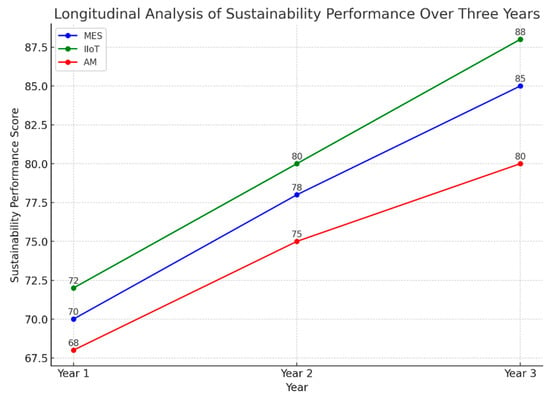
Figure 13.
Longitudinal analysis of sustainability performance over three years.
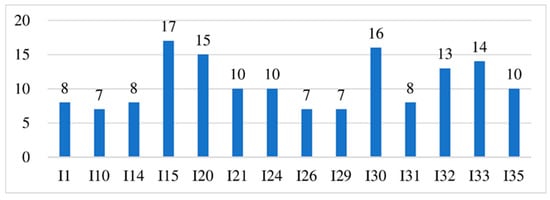
Figure 14.
Key Industry 4.0 technology core attribute values.
Description: this study demonstrates the impact of the integration of different Industry 4.0 technologies on the reduction in carbon emissions over a three-year time span. The X-axis of the line graph represents the years, the Y-axis carries the percentage of decline in the level of carbon emissions, and the various lines demonstrate the trends of the various technologies (e.g., MES, IIoT, AM, etc.) that have the potential to make this happen.
4.2. Cross-Sectoral Impact Assessment
4.2.1. Analysis of Industry-Specific Differences
The application of Industry 4.0 technologies can have markedly different outcomes across industries due to the unique demands of each sector, particularly regarding production process complexity, resource efficiency, and environmental impact. On the other hand, the chemical industry is involved in a few complex concerns regarding environmental contamination and energy use. MES integrated with IIoT can be the answer to shorten the list of pollution contributors and reduce energy consumption in the production processes.
4.2.2. Cross-Industry Comparative Study
This part, in turn, considers the same principles in the various industries, namely, the automotive, electronics, and chemical fields. For the automotive industry, research has discovered that production efficiency and cost reduction are significantly boosted by MES and IIoT technologies. By using the AM developments, the electronics manufacturing sector managed to reduce quite large amounts of waste while supporting creative production opportunities. While discussing the chemical industry, it is important to emphasize that, thanks to IIoT technology, air pollutants have dramatically decreased, and industrial production has become much safer. These various Industry 4.0 technology-oriented practices designed for sustainable development are demonstrated considering the cross-industry context.
4.2.3. Industry Adaptation Framework
To provide the tools and assistance to ensure a successful implementation of Industry 4.0 technologies in a variety of fields, this study suggests the “Industry Adaptation Framework” (IAF). The IAF model is value-based and categorizes industry sectors across the dimensions of eco-resources, environment, social behavior, and system flexibility, implying the need for a fitting technology app in the sector. This framework assists not only in pointing out the technology path that businesses should be following but also in constructing the theoretical basis for policymakers to promote the utilization of cross-industry technologies.
4.3. Implications for Industry
The importance and the impact of this research for manufacturing enterprises that are striving to support sustainability cannot be overemphasized. Evidence clearly indicates that adopting MES, IIoT, and AM can result in the most significant environmental and productive changes, making them an important part of any manufacturing strategy that aims to be sustainable. To give another example, real-time data provided by MES help manufacturers make educated decisions about production processes so they can efficiently reduce waste. Furthermore, IIoT enables meaningful maintenance procedures, as well as better resource distribution, and ultimately diminishes downtime and operating expenses. Once this is achieved, AM adds to the offer of precision manufacturing capability, which helps in the reduction of material waste as well as the localization of production, a critical aspect of climate change mitigation strategies. Manufacturers should adopt the technologies methodologically and in a phased manner to exploit their combined advantages. It is best if manufacturers start with MES to standardize and improve efficiency within the facility, then proceed with IIoT to unify all operations that depend on data and information, and finally integrate AM to introduce greener methods of production. Apart from this, the fact that AR, MR, and other similar systems are useful in improving job safety and in training workers points to incorporating these technologies into the broader bulk of corporate strategies, including those hatched to boost workplace productivity and create a friendly working environment (Table 8, Figure 15).

Table 8.
Longitudinal analysis of sustainability performance over three years.
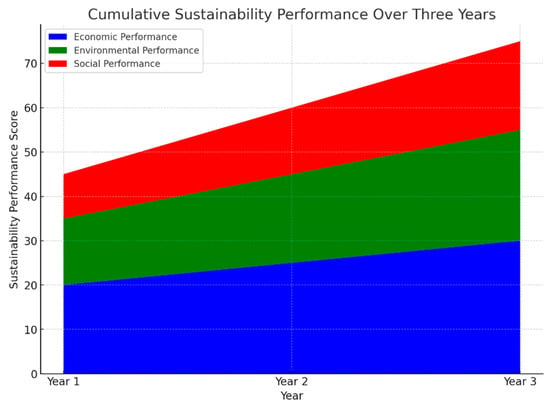
Figure 15.
Cumulative sustainability performance over three years.
Description: a bi-axial diagram showing the impact of Industry 4.0 technologies on productivity (left Y-axis) and societal benefits (e.g., workplace safety and employee training efficiency, right Y-axis). The X-axis represents the different Industry 4.0 technologies (MES, IIoT, AM, AR, MR, and ICT), and the biases show the change in the two types of metrics, respectively.
4.4. Limitations
While this study offers valuable insights into the role of Industry 4.0 technologies in sustainable manufacturing, it does have limitations. The research only involves 36 manufacturing enterprises located in Fujian Province. The fact that the research just focuses on an individual area as a case study has the potential to affect the outcomes since different factors, such as local policy guidelines or market circumstances from other areas, could be uninfluential. To address these limitations, future research should aim to broaden the scope of the study by including a more diverse set of businesses from dissimilar regions and sectors. This will help to validate the findings and offer a more complete picture of how Industry 4.0 technologies contribute to global sustainability. In addition to this, there can be deeper studies into how these technologies, in the long run, affect metrics on sustainability, in particular, the scalability and fitment in different operational areas [,].
5. Conclusions
This study demonstrates that the adoption of Industry 4.0 technologies—Manufacturing Execution Systems (MES), the Industrial Internet of Things (IIoT), and Additive Manufacturing (AM)—significantly enhances the sustainability performance of manufacturing enterprises in Fujian Province, China. Utilizing the Fuzzy Integration–Rough Set Theory (FI-RST) model, the impacts of these technologies were quantified across economic, environmental, and social dimensions.
The key findings include:
- Economic improvements: Implementing MES and IIoT led to cost reductions and operational efficiency gains, with firms reporting up to 22% productivity improvements and reduced downtime due to IIoT-enabled predictive maintenance.
- Environmental benefits: A 25–35% reduction in waste and a 15–20% decrease in energy consumption were observed, particularly in firms utilizing AM and IIoT, contributing to reduced carbon emissions.
- Social impacts: The integration of AR and IIoT improved worker safety and training efficiency, enhancing job satisfaction and reducing error rates.
This research bridges gaps in the existing literature by applying the FI-RST model to evaluate the combined effects of these technologies on sustainability. The findings highlight the importance of a holistic approach to Industry 4.0 implementation, as synergies between technologies are critical for maximizing sustainability outcomes.
5.1. Significance
This study provides a quantitative evaluation of the long-term sustainability impacts of Industry 4.0 technologies. It identifies the most impactful technologies for sustainable manufacturing, offering insights for policymakers and industry leaders. Future studies should explore the scalability of these technologies across different regions and sectors, laying the groundwork for policy frameworks and investment strategies [].
5.2. Contributions
This study advances understanding by showing how MES, IIoT, and AM contribute to improved efficiency, cost reductions, and environmental benefits. The FI-RST model provides a valuable tool for assessing the role of Industry 4.0 technologies in sustainable manufacturing, offering both theoretical insights and practical guidance for firms aiming to meet global sustainability goals.
5.3. Future Directions
Future research should explore the scalability and adaptability of these technologies in different industries and regions. Additionally, the long-term impacts of Industry 4.0 on sustainability metrics should be investigated through longitudinal studies. Cross-industry collaborative research could further reveal synergies between technologies, enhancing sustainability across supply chains []. Expanding sample sizes and conducting cross-regional comparisons will strengthen the generalizability of the findings.
Supplementary Materials
The following supporting information can be downloaded at: https://www.mdpi.com/article/10.3390/app14209545/s1, Table S1: Discriminant rate I and degree of dependency Y of the information physical system (CPS) with each enterprise. Table S2: Key Industry 4.0 technologies for manufacturing firms (δ = 0.5, k = 0.5). Table S3: Manufacturing Sustainability Performance Assessment Questionnaire. Table S4: Manufacturing Industry 4.0 Technology Assessment Questionnaire. Table S5: Sensitivity analysis statistics table.
Author Contributions
Conceptualization, Q.L. and W.T.; methodology, Q.L.; software, Q.L.; validation, Q.L., W.T. and Z.L.; formal analysis, Q.L.; investigation, Q.L.; resources, Q.L.; data curation, Q.L.; writing—original draft preparation, Q.L.; writing—review and editing, Q.L.; visualization, Q.L.; supervision, W.T.; project administration, W.T. All authors have read and agreed to the published version of the manuscript.
Funding
This research received no external funding.
Institutional Review Board Statement
Not applicable.
Informed Consent Statement
Informed consent was obtained from all subjects involved in the study.
Data Availability Statement
We regret that we are unable to disclose the original data due to privacy and ethical constraints. Access to the original data is governed by strict privacy and ethical guidelines. However, permission to access this original data can be granted upon request to the corresponding author, pending approval from the Ethics Committees.
Conflicts of Interest
The authors declare no conflict of interest.
References
- Alabadi, M.; Habbal, A.; Wei, X. Industrial Internet of Things: Requirements, Architecture, Challenges, and Future Research Directions. IEEE Access 2022, 10, 66374–66400. [Google Scholar] [CrossRef]
- Andronie, M.; Lăzăroiu, G.; Ștefănescu, R.; Uță, C.; Dijmărescu, I. Sustainable, Smart, and Sensing Technologies for Cyber-Physical Manufacturing Systems: A Systematic Literature Review. Sustainability 2021, 13, 5495. [Google Scholar] [CrossRef]
- Arifin, N.A.M.; Saman, M.Z.M.; Sharif, S.; Ngadiman, N.H.A. Sustainability Implications of Additive Manufacturing. Hum. Centered Technol. A Better Tomorrow 2021, 441–452. [Google Scholar] [CrossRef]
- Barari, A.; de Sales Guerra Tsuzuki, M.; Cohen, Y.; Macchi, M. Editorial: Intelligent manufacturing systems towards industry 4.0 era. J. Intell. Manuf. 2021, 32, 1793–1796. [Google Scholar] [CrossRef]
- Beregi, R.; Pedone, G.; Háy, B.; Váncza, J. Manufacturing Execution System Integration through the Standardization of a Common Service Model for Cyber-Physical Production Systems. Appl. Sci. 2021, 11, 7581. [Google Scholar] [CrossRef]
- Darwish, L.R.; El-Wakad, M.T.; Farag, M.M. Towards sustainable industry 4.0: A green real-time IIoT multitask scheduling architecture for distributed 3D printing services. J. Manuf. Syst. 2021, 61, 196–209. [Google Scholar] [CrossRef]
- Despeisse, M.; Ford, S. The Role of Additive Manufacturing in Improving Resource Efficiency and Sustainability. In Advances in Production Management Systems: Innovative Production Management towards Sustainable Growth; Springer: Cham, Switzerland, 2015; pp. 129–136. [Google Scholar] [CrossRef]
- Dutta, G.; Kumar, R.; Sindhwani, R.; Singh, R.K. Overcoming the barriers of effective implementation of manufacturing execution system in pursuit of smart manufacturing in SMEs. Procedia Comput. Sci. 2022, 200, 820–832. [Google Scholar] [CrossRef]
- Enyoghasi, C.; Badurdeen, F. Industry 4.0 for sustainable manufacturing: Opportunities at the product, process, and system levels. Resour. Conserv. Recycl. 2021, 166, 105362. [Google Scholar] [CrossRef]
- Li, K.; Zhou, T.; Liu, B. Internet-based intelligent and sustainable manufacturing: Developments and challenges. Int. J. Adv. Manuf. Technol. 2020, 108, 1767–1791. [Google Scholar] [CrossRef]
- Gomes, C.; Busanello, E.; Padilha, B.; Lerman, L.V.; Tabim, V.M. Exploring Key Factors for Implementing Manufacturing Execution Systems (MES) within the Framework of Industry 4.0 for Small and Medium-Sized Enterprises (SMEs) in the Manufacturing Sector. Production 2024, 34, e20230085. [Google Scholar] [CrossRef]
- Hegab, H.; Khanna, N.; Monib, N.; Salem, A. Design for sustainable additive manufacturing: A review. Sustain. Mater. Technol. 2023, 35, e00576. [Google Scholar] [CrossRef]
- Huang, S.H.; Liu, P.; Mokasdar, A.; Hou, L. Additive manufacturing and its societal impact: A literature review. Int. J. Adv. Manuf. Technol. 2012, 67, 1191–1203. [Google Scholar] [CrossRef]
- Jamwal, A.; Agrawal, R.; Sharma, M.; Giallanza, A. Industry 4.0 Technologies for Manufacturing Sustainability: A Systematic Review and Future Research Directions. Appl. Sci. 2021, 11, 5725. [Google Scholar] [CrossRef]
- Kalsoom, T.; Ahmed, S.; Rafi-ul-Shan, P.M.; Azmat, M.; Akhtar, P.; Pervez, Z.; Imran, M.A.; Ur-Rehman, M. Impact of IoT on Manufacturing Industry 4.0: A New Triangular Systematic Review. Sustainability 2021, 13, 12506. [Google Scholar] [CrossRef]
- Kamble, S.; Gunasekaran, A.; Dhone, N.C. Industry 4.0 and lean manufacturing practices for sustainable organisational performance in Indian manufacturing companies. Int. J. Prod. Res. 2019, 58, 1–19. [Google Scholar] [CrossRef]
- Machado, C.G.; Winroth, M.P.; Ribeiro da Silva, E.H.D. Sustainable manufacturing in Industry 4.0: An emerging research agenda. Int. J. Prod. Res. 2019, 58, 1462–1484. [Google Scholar] [CrossRef]
- Malik, P.K.; Sharma, R.; Singh, R.; Gehlot, A.; Satapathy, S.C.; Alnumay, W.S.; Pelusi, D.; Ghosh, U.; Nayak, J. Industrial Internet of Things and its applications in industry 4.0: State of the art. Comput. Commun. 2020, 166, 125–139. [Google Scholar] [CrossRef]
- Manavalan, E.; Jayakrishna, K. A review of Internet of Things (IoT) embedded sustainable supply chain for industry 4.0 requirements. Comput. Ind. Eng. 2019, 127, 925–953. [Google Scholar] [CrossRef]
- Mantravadi, S.; Møller, C. An Overview of Next-generation Manufacturing Execution Systems: How important is MES for Industry 4.0? Procedia Manuf. 2019, 30, 588–595. [Google Scholar] [CrossRef]
- Naghshineh, B.; Ribeiro, A.; Jacinto, C.; Carvalho, H. Social impacts of additive manufacturing: A stakeholder-driven framework. Technol. Forecast. Soc. Chang. 2021, 164, 120368. [Google Scholar] [CrossRef]
- Peng, T.; Kellens, K.; Tang, R.; Chen, C.; Chen, G. Sustainability of additive manufacturing: An overview on its energy demand and environmental impact. Addit. Manuf. 2018, 21, 694–704. [Google Scholar] [CrossRef]
- Novák, P.; Vyskočil, J.; Kadera, P. Plan Executor MES: Manufacturing Execution System Combined with a Planner for Industry 4.0 Production Systems. In Lecture Notes in Computer Science; Springer: Cham, Switzerland, 2019; pp. 67–80. [Google Scholar] [CrossRef]
- Pfeifer, M.R. Development of a Smart Manufacturing Execution System Architecture for SMEs: A Czech Case Study. Sustainability 2021, 13, 10181. [Google Scholar] [CrossRef]
- Pivoto, D.G.S.; de Almeida, L.F.F.; da Rosa Righi, R.; Rodrigues, J.J.P.C.; Lugli, A.B.; Alberti, A.M. Cyber-physical systems architectures for industrial internet of things applications in Industry 4.0: A literature review. J. Manuf. Syst. 2021, 58, 176–192. [Google Scholar] [CrossRef]
- Qi, Q.; Xu, Z.; Rani, P. Big data analytics challenges to implementing the intelligent Industrial Internet of Things (IIoT) systems in sustainable manufacturing operations. Technol. Forecast. Soc. Chang. 2023, 190, 122401. [Google Scholar] [CrossRef]
- Rahardjo, B.; Wang, F.-K.; Yeh, R.-H.; Chen, Y.-P. Lean Manufacturing in Industry 4.0: A Smart and Sustainable Manufacturing System. Machines 2023, 11, 72. [Google Scholar] [CrossRef]
- Besutti, R.; Vanessa; Cecconello, I. Development of an open source-based manufacturing execution system (MES): Industry 4.0 enabling technology for small and medium-sized enterprises. Sci. Cum Ind. 2019, 7, 1–11. Available online: https://sou.ucs.br/etc/revistas/index.php/scientiacumindustria/article/view/6602 (accessed on 23 April 2019). [CrossRef]
- Ruiz Zúñiga, E.; Syberfeldt, A.; Urenda Moris, M. The Internet of Things, Factory of Things and Industry 4.0 in Manufacturing: Current and Future Implementations; IOS Press: Amsterdam, The Netherland, 2017. [Google Scholar] [CrossRef]
- Ryalat, M.; ElMoaqet, H.; AlFaouri, M. Design of a Smart Factory Based on Cyber-Physical Systems and Internet of Things towards Industry 4.0. Appl. Sci. 2023, 13, 2156. [Google Scholar] [CrossRef]
- Favela-Camacho, S.M.; Molina-Salazar, J.; Rico-Pérez, L. Manufacturing Execution System State-Of-The-Art: Its Evolution and Dynamism Focused on Industry 4.0; Springer EBooks: Cham, Switzerland, 2021; pp. 245–262. [Google Scholar] [CrossRef]
- Shojaeinasab, A.; Charter, T.; Jalayer, M.; Khadivi, M.; Ogunfowora, O.; Raiyani, N.; Yaghoubi, M.; Najjaran, H. Intelligent manufacturing execution systems: A systematic review. J. Manuf. Syst. 2022, 62, 503–522. [Google Scholar] [CrossRef]
- Stock, T.; Seliger, G. Opportunities of Sustainable Manufacturing in Industry 4.0. Procedia CIRP 2016, 40, 536–541. [Google Scholar] [CrossRef]
- Taddese, G.; Durieux, S.; Duc, E. Sustainability performance indicators for additive manufacturing: A literature review based on product life cycle studies. Int. J. Adv. Manuf. Technol. 2020, 107, 3109–3134. [Google Scholar] [CrossRef]
- Walter, A.; Marcham, C.L. Environmental Advantages in Additive Manufacturing. Prof. Saf. 2020, 65, 34–38. Available online: https://onepetro.org/PS/article-abstract/65/01/34/33552/Environmental-Advantages-in-Additive-Manufacturing (accessed on 1 January 2020).
Disclaimer/Publisher’s Note: The statements, opinions and data contained in all publications are solely those of the individual author(s) and contributor(s) and not of MDPI and/or the editor(s). MDPI and/or the editor(s) disclaim responsibility for any injury to people or property resulting from any ideas, methods, instructions or products referred to in the content. |
© 2024 by the authors. Licensee MDPI, Basel, Switzerland. This article is an open access article distributed under the terms and conditions of the Creative Commons Attribution (CC BY) license (https://creativecommons.org/licenses/by/4.0/).